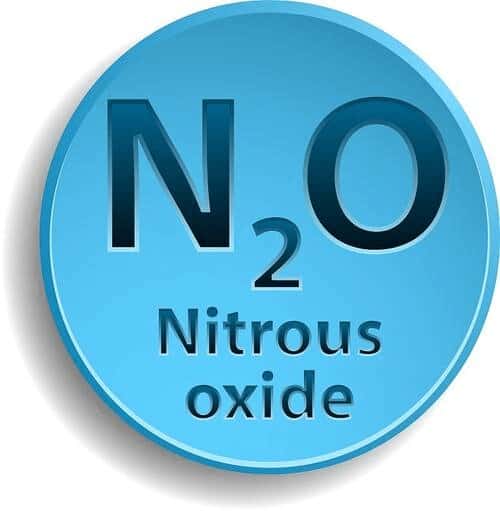poháněné PiQR.io
poháněné PiQR.io


Oxid dusný (N₂O), poprvé syntetizovaný v roce 1772 Josephem Priestleym, se začal široce používat v lékařské praxi poté, co Gardner Colton a Horace Wells v roce 1844 prokázali jeho analgetické účinky. Po uvedení lahví se stlačeným plynem na trh v roce 1868 se oxid dusný stal klíčovým doplňkem pro zubní sedaci, porodnickou analgezii a celkovou anestezii. Mezi jeho klinické výhody patří bezproblémová indukce, snížené používání primárních anestetik, kardiovaskulární stabilita a rychlé pooperační zotavení.
Navzdory jeho prokázané klinické hodnotě vyvolávají obavy z jeho vedlejších metabolických účinků (např. potlačení metabolismu folátů), bezpečnostních rizik zařízení a jeho vlivu jako silného skleníkového plynu neustálé diskuse již od poloviny 19. století. Je však důležité poznamenat, že na lékařské použití připadá pouze 2% celosvětových emisí oxidu dusného, což naznačuje omezený příspěvek k životnímu prostředí.
Tento přehled se zaměřuje na dětskou anestezii a popisuje farmakologické vlastnosti, přínosy a rizika použití oxidu dusného a jeho možný vliv na vývoj nervové soustavy. Kromě toho stručně představujeme jeho regulované nemedicínské aplikace.

Oxid dusný (N₂O), běžně známý jako smíchový plyn, je bezbarvý plyn se sladkým zápachem při standardní teplotě a tlaku. Je chemicky stabilní, jeho molekulová hmotnost je 44,01 g/mol, bod varu -88,48 °C a bod tání -90,8 °C. Je rozpustný ve vodě a organických rozpouštědlech.
Oxid dusný působí především inhibicí neurotransmise v centrální nervové soustavě. Interaguje s mnoha receptory, včetně receptorů pro N-methyl-D-aspartát (NMDA) a receptorů pro kyselinu gama-aminomáselnou (GABA), čímž tlumí neuronální excitabilitu a vyvolává sedativní, analgetické a anestetické účinky. Kromě toho oxid dusný ovlivňuje intracelulární signální dráhy a moduluje uvolňování neurotransmiterů, čímž zvyšuje svou farmakologickou účinnost.
Oxid dusný podléhá v těle minimálnímu metabolismu. Přibližně 80%-90% vdechnutého oxidu dusného je vydechnuto plícemi v nezměněné podobě, zatímco zbytek je po krátké době pobytu postupně vyloučen. Vzhledem k nízké rychlosti metabolismu se oxid dusný v těle hromadí minimálně a má malý vliv na funkci jater a ledvin.
Synergická anestezie: Oxid dusný, často kombinovaný s éterem nebo sevofluranem, usnadňuje hladší indukci a snižuje dávkování a vedlejší účinky primárních anestetik (např. minimalizuje podráždění dýchacích cest a kardiopulmonální depresi způsobenou éterem).
Kardiopulmonální stabilita: Má minimální kardiovaskulární útlum, takže je vhodný pro dětské pacienty s komorbidními srdečními nebo plicními chorobami a zvyšuje bezpečnost anestezie.
Rychlé zotavení: Vzhledem k nízkému metabolismu a primárnímu způsobu vydechování se dětští pacienti po ukončení podávání rychle probouzejí k vědomí a mají méně pooperačních komplikací, jako je agitovanost, nevolnost nebo zvracení.
Účinná analgezie: Oxid dusný lze použít samostatně nebo v kombinaci s ním při drobných zákrocích a diagnostických operacích, kdy účinně tlumí bolest a předchází vedlejším účinkům spojeným se silnějšími analgetiky.
Metabolická rizika: Dlouhodobá expozice nebo expozice vysokým dávkám může inhibovat syntetázu methioninu, což vede k poruchám metabolismu folátů a poruchám syntézy DNA, které mohou významně ovlivnit rychle se dělící buňky, jako je kostní dřeň a nervová tkáň.
Bezpečnostní rizika: Poruchy zařízení (např. netěsnosti, nesprávné zapojení) mohou vést k hypoxii. Ve směsi s hořlavými plyny představuje oxid dusný riziko výbuchu, což vyžaduje přísné kontroly prostředí.
Neuro-vývojové problémy: Potenciální neurotoxické účinky u dětí jsou nadále předmětem zkoumání. Dlouhodobá expozice vysokým koncentracím může způsobit apoptózu neuronů a synaptické abnormality, ačkoli bezpečnost krátkodobého klinického použití je stále diskutována.
Dopad na životní prostředí: Oxid dusný je skleníkovým plynem s potenciálem globálního oteplování 300krát vyšším než CO₂, a proto zůstává problémem v oblasti udržitelné zdravotní péče, přestože na lékařské použití připadá pouze 2% celkových emisí.

Oxid dusný se používá především k předoperační sedaci a intraoperační analgezii v dětské chirurgii. Je vhodný zejména pro zákroky, jako jsou stomatologické práce (např. výplně, extrakce), excize povrchových útvarů a obřízka. Vdechováním směsi kyslíku a oxidu dusného dochází u dětí k rychlé sedaci, snížení úzkosti a úlevě od intraoperační bolesti - často ve spojení s lokální anestezií pro účinnou léčbu bolesti.
Oxid dusný má ve srovnání s intravenózními sedativy několik praktických výhod:
Neinvazivní a pohodlné: Eliminuje potřebu infuzního přístupu, minimalizuje bolest a strach u dětí a zlepšuje přijetí jak pacienty, tak lékaři.
Dynamické řízení: Inhalační koncentraci lze upravovat v reálném čase podle potřeb chirurgického zákroku, což umožňuje přesnou kontrolu nad hloubkou sedace a analgezie.
Rychlý obrat: Rychlý nástup a zotavení optimalizují klinický pracovní postup a efektivitu postupů.
Oběti popálenin, zejména děti, pociťují při ošetřování ran a výměně obvazů silnou bolest. Analgetické vlastnosti oxidu dusného účinně zmírňují bolest a zvyšují pohodlí. Jeho sedativní účinky také snižují úzkost a emocionální stres, což usnadňuje lepší hojení ran a dodržování léčby.
Oxid dusný má potenciální využití při léčbě chronických bolestivých stavů, jako je bolest související s rakovinou a neuropatická bolest. Dočasná úleva od bolesti prostřednictvím inhalace může zlepšit kvalitu života. Dlouhodobé používání při léčbě chronických onemocnění však vyžaduje pečlivé sledování jeho metabolických nežádoucích účinků a možného vlivu na neurovývoj.
Vzhledem k jeho specifickým fyzikálně-chemickým vlastnostem musí být oxid dusný používán v dobře regulovaném právním a bezpečnostním rámci, zejména aby se zabránilo jeho zneužívání v nelékařských zařízeních:
Lékařské použití: Musí být pořízeny prostřednictvím licencovaných zdravotnických zařízení a musí splňovat mezinárodní anesteziologické směrnice (např. standardy kontroly koncentrace doporučené WHO).
Potravinářský průmysl: Používá se jako šlehací prostředek (např. v dávkovačích smetany) a musí splňovat mezinárodní předpisy pro potravinářské přídatné látky, jako je nařízení EU č. 1333/2008.

V posledních letech některé skupiny rekreačně používají oxid dusný k vyvolání krátkodobé euforie, což představuje vážné bezpečnostní riziko:
Zdravotní rizika: Akutní expozice vysokým koncentracím může způsobit hypoxii a udušení. Dlouhodobé zneužívání potlačuje syntézu vitaminu B12, což může vést k nevratné periferní neuropatii a útlumu kostní dřeně - zvláště škodlivé pro vyvíjející se nervový systém dospívajících.
Provozní rizika: Neprofesionální vybavení (např. upravené nabíječky krémů nebo horší nafukovačky) zvyšuje riziko úniku plynu, tlakových nehod, omrzlin a poškození plic.
Oxid dusný zůstává v dětské anestezii cenným prostředkem, který vedle možných rizik přináší i významné klinické výhody. Při přesném dávkování, bezpečném zacházení a individuálním posouzení lze maximalizovat jeho terapeutické účinky a zároveň minimalizovat škody.
Kromě své zásadní role v pediatrické medicíně je oxid dusný široce používán také jako bezpečný a kontrolovaný hnací plyn pro potravinářské účely, zejména v systémy nabíjení krémů.
Jako profesionální výrobce, Cream Deluxe se zavázala vyrábět vysoce kvalitní nabíječky oxidu dusného, které splňují mezinárodní bezpečnostní normy pro použití v potravinářském průmyslu. Naše výrobky nabízejí účinná a pohodlná řešení pro přípravu šlehačky a kulinářské inovace.
Chcete-li získat další informace o různých aplikacích oxidu dusného, neváhejte nás kontaktovat. Dovolte vědě, aby pozvedla váš klinická excelence a kulinářská kreativita.
| Cookie | Doba trvání | Popis |
|---|---|---|
| cookielawinfo-checkbox-analytics | 11 měsíců | Tento soubor cookie je nastaven pomocí pluginu GDPR Cookie Consent. Tento soubor cookie slouží k uložení souhlasu uživatele se soubory cookie v kategorii "Analytika". |
| cookielawinfo-checkbox-functional | 11 měsíců | Soubor cookie je nastaven na základě souhlasu s GDPR, aby zaznamenal souhlas uživatele se soubory cookie v kategorii "Funkční". |
| cookielawinfo-checkbox-necessary | 11 měsíců | Tento soubor cookie je nastaven pomocí pluginu GDPR Cookie Consent. Soubor cookie slouží k uložení souhlasu uživatele se soubory cookie v kategorii "Nezbytné". |
| cookielawinfo-checkbox-others | 11 měsíců | Tento soubor cookie je nastaven pomocí pluginu GDPR Cookie Consent. Tento soubor cookie slouží k uložení souhlasu uživatele se soubory cookie v kategorii "Ostatní. |
| cookielawinfo-checkbox-others | 11 měsíců | Tento soubor cookie je nastaven pomocí pluginu GDPR Cookie Consent. Tento soubor cookie slouží k uložení souhlasu uživatele se soubory cookie v kategorii "Ostatní. |
| cookielawinfo-checkbox-performance | 11 měsíců | Tento soubor cookie je nastaven pomocí pluginu GDPR Cookie Consent. Tento soubor cookie slouží k uložení souhlasu uživatele se soubory cookie v kategorii "Výkon". |
| viewed_cookie_policy | 11 měsíců | Tento soubor cookie je nastaven pomocí zásuvného modulu GDPR Cookie Consent a slouží k uložení informace, zda uživatel souhlasil s používáním souborů cookie. Neukládá žádné osobní údaje. |